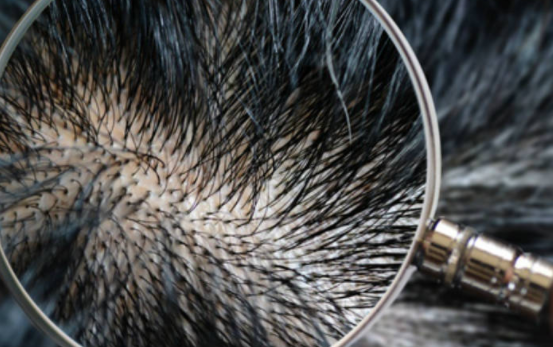Do you have an ingrown hair on scalp? How does ingrown hair on your scalp look like? Could it be an infection on the skin? In this article, learn more on how you can identify the symptoms, causes and how you can treat ingrown hair on your scalp fast.
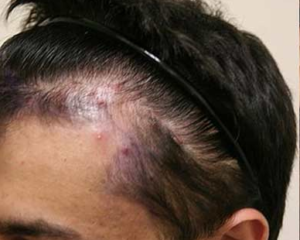
A bump on your head with hair trapped in happens when the sharp edges of the hair grow downwards or sideways back cutting into the skin of the hair follicle. Ingrown on your scalp is a common hair condition and shouldn’t be a cause for alarm. If you have an infected scalp such that there is a cyst that might necessitate treatment from a local dermatologist in your town.
Experts believe that pimples on scalp is more common to men with coarse hairs such as the African American. Ingrown hair is said to be harmless but only in some cases where it could lead to scarring, skin discoloration and scar formation.
Ingrown hair on scalp pictures
How do ingrown hair on the scalp appear like? To help you understand how razor bumps on your scalp appear or look like, below is a picture of infected ingrown hair on your head. We also have more images and photos in the post to help you identify with your symptoms.
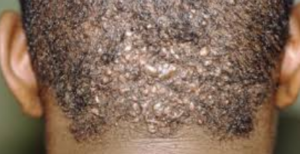
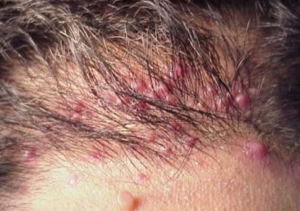
Ingrown hair on scalp symptoms
What are the symptoms and signs of ingrown hair on skin of the scalp? Hair trapped in the skin of your scalp mostly appear in males particularly the chin area and the cheeks. Males are more prone to have bumps on their scalp since they have a tendency to shave more than the females.
Where as in females ingrown hair appear more on the armpits, pubic area and the legs, you may notice some similarities in the symptoms and signs that can also be found in males as well. Here are the symptoms of pimple on scalp:
- You may experience itch and pain on your scalp
- Red or pink like bumps on the skin indicating inflammation
- If the ingrown hair is infected, you may experience pus-filled bumps
- They may at times appear like tiny pimples with a white head
- Dark spot at the center of a bump showing trapped hair growing
What causes ingrown hairs on scalp
A hair can be ingrown in two different broad categories. You may have ingrown hair that grows straight out of the hair follicle then it curls back growing sideways piercing the skin of scalp also known as extrafollicular penetration. The other second way you develop ingrown hair is by the hair growing underneath trapped in the skin or what is known as transfollicular penetration.
An ingrown hair in your head or scalp can be caused by number of reasons but your hair removal methods such as waxing, shaving or tweezing can be the reason you have ingrown hair on your scalp. Here are the causes of ingrown hair on your head.
- As stated above, if you use poor shaving techniques in removing hair on your head, you are likely to get ingrown hair on your scalp. Basically if you have the tendency of not taking precautionary measures during shaving or reducing hair on your head, you are likely to develop tiny red bumps on your scalp which can be painful.
- If you have ingrown hair on your scalp, it could be due to clogged hair follicle on your head. The hair follicles can harbor dead skin cells and debris. This can cause the tip of the hair to grow sideways and downwards back to the skin of the scalp.
- Ingrown hair on scalp is commonly identified with men who have curled hair especially the African – American. Such tightly curled hair tend to grow sideways and the tip cuts the skin of the scalp trapping the hair back.
- Skin irritating chemicals and other counterfeit beauty hair products are linked to be the cause of the ingrown hair on the scalp. Such products are believed to cause irritation of the skin making the scalp to have cluster of bumps on your scalp with hair trapped in.
- Accumulation dirt and pore clogging skin care products can be the reason you have pimples on your scalp with hair trapped in.
- You may have ingrown hair on your scalp as a result of the genetic and general health, this can influence the more hair growth which get trapped in the skin.
What does an ingrown hair on scalp feel like or appear like?
Ingrown hair on your scalp can appear like small sometimes raised red or pink bumps on the skin. If you spot clusters on your scalp that are often scattered throughout the area that is already shaved, then you have ingrown hair. In some cases, they are appear as tiny pimples with a white head with a visible black dot at the center of the razor bumps where the hair is trapped.
If you have an inflammation of the skin around the area where the ingrown hair is trapped, it ma y appear reddish which at times is pus-filled. This can make you feel discomfort and itchy coupled with pain.
Ingrown hair on scalp shouldn’t be mistaken with other skin conditions which appear like trapped hair growing underneath the skin. For instances, acne, cyst atopic dermatitis, eczema or heat rush are some of the commonly mistaken conditions that resembles ingrown hair on the scalp.
Big ingrown hair on scalp long hair
Can you get big Ingrown hair on your head from long hair? If you have an infected ingrown hair follicle, sometimes the surrounding skin on your scalp gets inflamed and can spread deep down into the hair follicle. The result is a raised big ingrown that appear like a bump in your long hair. Occasionally you may spot a puss- filled ingrown hair that itch and painful.
In some people, they develop a big ingrown hair cyst that gets trapped deep underneath the skin making it impossible to remove with a pair of tweezers.
An occasional ingrown hair shouldn’t warrant any reason for concern. However, if the ingrown hair is as a result of long hair growth (hirsutism), your doctor can tell if the excessive long hair growth can be a treatable hormonal abnormalities such as polycystic ovary syndrome.
Ingrown hair scalp cyst
Do you have an ingrown hair cyst on your scalp? Ingrown hair on scalp cyst is basically a hair follicle cyst also called trichilemmal cyst. It is worthwhile to know that ingrown hair cyst are mostly found on the scalp. These kind of cysts are smooth in appearance, mobile and are normally filled with keratin.
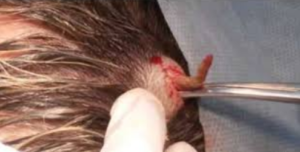
Trichilemmal cyst is believed to be a genetic condition that tends to run in families. If you have ingrown hair cyst it may appear tender or inflamed. However, that entirely depends on whether the cyst on your scalp is ruptured or not.
Treatment of ingrown hair cyst on scalp can be done through surgical excision. According to Wikipedia, the method of treatment of an ingrown hair cyst on scalp varies depending on the physician training. While some physician prefer performing the surgical procedure under local anesthetic others would do it in a more conservative approach.
Usually your healthcare provider will carry a biopsy test to treat bumps with hair on scalp cyst.
Ingrown hair on scalp after haircut
Can you get ingrown hair after haircut or shaving your head? Strange bumps might pop up on your scalp after haircut, sometimes dead skins and on your head can clog up the hair follicles of your scalp resulting to hair growing underneath the skin of your scalp.
Men who have the tendency of using razor burn to cut hair on scalp, chin or cheek are likely to get bumps with hair trapped in. Treatment involves shaving properly, avoid applying too much pressure to the razor and shaving too close to the scalp.
After haircut, cleanse the skin of scalp with preferably that contains salicylic acid, this will prevent the pores of the hair follicle of your scalp from clogging.
Infected ingrown hair on scalp- Folliculitis on scalp
If you have an inflammatory disorder of the hair follicles on your scalp, you are probably suffering from scalp folliculitis. Also known as acne necrotica or proprionibacterium folliculitis, this condition appears on your scalp as small, itchy and cause trouble on the frontal hair line on the scalp.
If you have a bacterial or yeast infection on your scalp, the ingrown hair on your scalp becomes inflamed causing yellowish or pus discharge that can be painful. Treatment for folliculitis on scalp involves washing the infected scalp with shampoo as much as you can. You may be required to buy antidandruff shampoos to remove the ingrown hair completely.
Alternatively, if the infected scalp does not cause any serious health risk, use topical antibiotics such as fusidic acid gel or clindamycin to wash your scalp.
How to treat ingrown hair on scalp
Ingrown hair on scalp should be able to heal on its own spontaneously without necessarily treating it. However, if you have a case of severe trapped hair on your scalp, your doctor can help you determine the safest treatment for you condition. Here is how to treat ingrown hair on your head.
- Wash the affected area with antibacterial soap or shampoo your hair
- Apply topical cream on the infected area. Your doctor will prescribe for you one that is suited for your condition. This will help to decrease the build of dead skin cells on your scalp that can block pores.
- Use antibiotics and sometimes oral antibiotics, this will depend if you have secondary bacterial infection on your scalp.
- Big infected ingrown hair on your scalp can be removed through surgical procedure to prevent it from spreading deep into the skin.
Sources and citations:
- http://www.emedicinehealth.com/ingrown_hair/page3_em.htm – ingrown_hair_treatment_and_removal
- Trichilemmal cyst: https://en.wikipedia.org/wiki/Trichilemmal_cyst
- Scalp folliculitis : http://www.dermnetnz.org/acne/scalp-folliculitis.html
- http://www.mayoclinic.org/diseases-conditions/folliculitis/basics/causes/con-20025909
